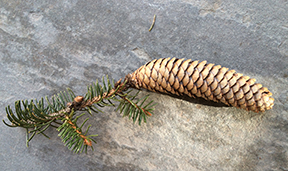It’s Only Fun If You Get a Scar Out of It
 Recently, I was brought down by a rogue pine cone. Yes, a pine cone. In my defense, it was one of those really fresh, hard cylindrical ones whose scales were clamped tightly shut. Picture a lumberjack during a log-rolling contest. You get the idea. The evil pine cone was positioned perfectly in wait as I stepped out of my car. My heel struck it at the right (or wrong) angle, and I rolled across it and landed on my butt, flailing maniacally on the way down. So now, I have a brand new, rather deep scrape on my hand which will become a scar.
Recently, I was brought down by a rogue pine cone. Yes, a pine cone. In my defense, it was one of those really fresh, hard cylindrical ones whose scales were clamped tightly shut. Picture a lumberjack during a log-rolling contest. You get the idea. The evil pine cone was positioned perfectly in wait as I stepped out of my car. My heel struck it at the right (or wrong) angle, and I rolled across it and landed on my butt, flailing maniacally on the way down. So now, I have a brand new, rather deep scrape on my hand which will become a scar.
Another scar. Another tale. This one was a little funny. Vanquished by a pine cone. I’ve also been defeated by a banana peel, but that’s another story. I have a lot of scars. Each one marks a chapter in my life. There’s the lightning-shaped scar on the back of my hand when I fell off the school bus as my heel got caught in my skirt hem (eat your heart out, Harry Potter). The spot near my lip from the dreaded Shingles Episode of ’84. The former location of cysts that were thankfully benign. The spots where IVs were inserted, and of course, the Frankenstein railroad track scars from numerous operations back in the day before surgeons developed more aesthetically pleasing techniques of sewing up muscle and skin.
But as Astrid, the teenaged recruit from How to Train Your Dragon, says nonchalantly about dragon-fighting lessons, “It’s only fun if you get a scar out of it.” I don’t mind them too much nowadays. Scars are a badge of honor. Proof that I have survived and healed — that I’ve overcome adversity or stupidity. And as Kelly Clarkson paraphrases Nietzche, “What doesn’t kill you makes you stronger.” Some scientific studies suggest that small amounts of trauma make us more resilient, helping us develop coping skills for difficult times we might encounter in the future. I believe that.
 The Japanese have a beautiful art form called kintsugi; broken pieces of ceramics are repaired using gold and lacquer. Instead of trying to disguise the damage, they embrace it. Like the philosophy of wabi-sabi (seeing the beauty in imperfection), the cracks and flaws in a shattered cup or broken plate are emphasized, enhanced and celebrated. The origin is said to date back to the 15th century, when a servant broke the prized bowl of a Japanese Shogun. The Shogun sent to bowl back to China to be repaired but was unhappy with the look of the metal staples used to hold the pieces back together. He ordered his artisans to devise a more visually attractive solution. They lacquered the pieces together and highlighted the “scars” with gold. The bowl became more beautiful and its value elevated for having been broken.
The Japanese have a beautiful art form called kintsugi; broken pieces of ceramics are repaired using gold and lacquer. Instead of trying to disguise the damage, they embrace it. Like the philosophy of wabi-sabi (seeing the beauty in imperfection), the cracks and flaws in a shattered cup or broken plate are emphasized, enhanced and celebrated. The origin is said to date back to the 15th century, when a servant broke the prized bowl of a Japanese Shogun. The Shogun sent to bowl back to China to be repaired but was unhappy with the look of the metal staples used to hold the pieces back together. He ordered his artisans to devise a more visually attractive solution. They lacquered the pieces together and highlighted the “scars” with gold. The bowl became more beautiful and its value elevated for having been broken.
Think of your scars (both visible and hidden) as tattoos of survival — the gold that adds value to your life: the experiences that have made you stronger or taught you lessons (like look out for pine cones), the stories of all you have overcome. Paint your scars in gold and shine. We are all more beautiful for having been broken.
Most of us over a certain age (such as former toddlers) have a scar or three both visual or metaphorical. I’m glad your newest scar is going to be physical. Your relating of the Japanese way of repairing an item is at once educational and inspiring. It must be a beautiful art form and at the same time makes one realize that the repairing of an injury makes something even more beautiful, unique and valuable than before. Thanks for sharing, Donna!
All I can say is WOW! What a great article. I think that you are a really great writer and and even better philosopher. I read (have read) all your blog articles through the years but this one is my favorite. Keep going!